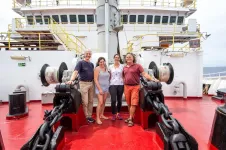(Press-News.org) An upsurge of matter from deep beneath the Earth's crust could be pushing the continents of North and South America further apart from Europe and Africa, new research has found.
The plates attached to the Americas are moving apart from those attached to Europe and Africa by four centimetres per year. In between these continents lies the Mid-Atlantic Ridge, a site where new plates are formed and a dividing line between plates moving to the west and those moving to the east; beneath this ridge, material rises to replace the space left by the plates as they move apart.
Conventional wisdom is that this process is normally driven by distant gravity forces as denser parts of the plates sink back into the Earth. However, the driving force behind the separation of the Atlantic plates has remained a mystery because the Atlantic ocean is not surrounded by dense, sinking plates.
Now a team of seismologists, led by the University of Southampton, have found evidence of an upwelling in the mantle - the material between the Earth's crust and its core - from depths of more than 600 kilometres beneath the Mid Atlantic ridge, which could be pushing the plates from below, causing the continents to move further apart.
Upwellings beneath ridges are typically thought to originate from much shallower depths of around 60 km.
The findings, published in the journal Nature provide a greater understanding of plate tectonics which causes many natural disasters around the world, including earthquakes, tsunamis and volcanic eruptions.
Over two research cruises on the RV Langseth and RRV Discovery, the team deployed 39 seismometers at the bottom of the Atlantic as part of the PI-LAB (Passive Imaging of the Lithosphere-Asthenosphere Boundary) experiment and EURO-LAB (Experiment to Unearth the Rheological Oceanic Lithosphere-Asthenosphere Boundary). The data provides the first large scale and high-resolution imaging of the mantle beneath the Mid-Atlantic Ridge.
This is one of only a few experiments of this scale ever conducted in the oceans and allowed the team to image variations in the structure of the Earth's mantle near depths of 410 km and 660 km - depths that are associated with abrupt changes in mineral phases. The observed signal was indicative of a deep, sluggish and unexpected upwelling from the deeper mantle.
Lead author, Matthew Agius, a former post-doctoral fellow at the University of Southampton and currently at Università degli studi Roma Tre said: "This was a memorable mission that took us a total of 10 weeks at sea in the middle of the Atlantic Ocean. The incredible results shed new light in our understanding of how the Earth interior is connected with plate tectonics, with observations not seen before."
Dr Kate Rychert and Dr Nick Harmon from the University of Southampton and Professor Mike Kendall from the University of Oxford led the experiment and were the chief scientists on the cruises. The experiment was funded by NERC (Natural Environment Research Council, UK) and the ERC (European Research Council).
Dr Harmon said: "There is a growing distance between North America and Europe, and it is not driven by political or philosophical differences - it is caused by mantle convection!"
As well as helping scientists to develop better models and warning systems for natural disasters, plate tectonics also has an impact on sea levels, and therefore affects climate change estimates over geologic times scales.
Dr Rychert said: "This was completely unexpected. It has broad implications for our understanding of Earth's evolution and habitability. It also demonstrates how crucial it is to gather new data from the oceans. There is so much more to explore!"
Professor Mike Kendall added: "This work is exciting and that it refutes long held assumptions that mid-ocean ridges might play a passive role in plate tectonics. It suggests that in places such as the Mid-Atlantic, forces at the ridge play an important role in driving newly-formed plates apart."
INFORMATION:
Notes to editors
For further information and interview requests, please contact Steve Bates, Media Relations Officer, University of Southampton; s.d.bates@soton.ac.uk, 07342 060429.
Explainer videos and images of the research trips are available here. Please credit to University of Southampton.
Scientists have resolved a key climate change mystery, showing that the annual global temperature today is the warmest of the past 10,000 years - contrary to recent research, according to a Rutgers-led study in the journal Nature.
The long-standing mystery is called the "Holocene temperature conundrum," with some skeptics contending that climate model predictions of future warming must be wrong. The scientists say their findings will challenge long-held views on the temperature history in the Holocene era, which began about 12,000 years ago.
"Our reconstruction shows that the first half of the Holocene was colder than in industrial times due to the cooling effects of remnant ice sheets from the previous glacial period - contrary to previous reconstructions of global temperatures," ...
STOCKHOLM: With impacts from climate change threatening to be as abrupt and far-reaching in the coming years as the current pandemic, leading scientists have released a compilation of the 10 most important insights on the climate from the last year to help inform collective action on the ongoing climate crisis.
In a report presented today to Patricia Espinosa, Executive Secretary of the United Nations Framework Convention on Climate Change (UNFCCC), report authors outlined some of 2020's most important findings within the field of climate science, ranging from improved models that reveal the need for aggressive emission cuts in order to meet the Paris Agreement to the growing use of human rights litigation to catalyze climate action.
The report alleviates some worries that ...
In experiments at the Paul Scherrer Institute PSI, an international research collaboration has measured the radius of the atomic nucleus of helium five times more precisely than ever before. With the aid of the new value, fundamental physical theories can be tested and natural constants can be determined even more precisely. For their measurements, the researchers needed muons - these particles are similar to electrons but are around 200 times heavier. PSI is the only research site in the world where enough so-called low-energy muons are produced for such experiments. The researchers are publishing their results today in the journal Nature.
After hydrogen, helium is the second most abundant element in the universe. Around one-fourth of the ...
People with schizophrenia, a mental disorder that affects mood and perception of reality, are almost three times more likely to die from the coronavirus than those without the psychiatric illness, a new study shows. Their higher risk, the investigators say, cannot be explained by other factors that often accompany serious mental health disorders, such as higher rates of heart disease, diabetes, and smoking.
Led by researchers at NYU Grossman School of Medicine, the investigation showed that schizophrenia is by far the biggest risk factor (2.7 times increased odds of dying) after ...
The inner ear of a 400 million-year-old 'platypus fish' has yielded new insights into early vertebrate evolution, suggesting this ancient creature may be more closely related to modern-day sharks and bony fish than previously thought.
A team of scientists from the University of Birmingham in the UK, and institutions in China, Australia and Sweden, used 'virtual anatomy' techniques, including MicroCT scanning (using x-rays to look inside the fossil) and digital reconstruction to examine previously unseen areas within the braincase of these mysterious fossils.
They discovered the fish, called ...
BOSTON -- For the first time, scientists have identified the individual neurons critical to human social reasoning, a cognitive process that requires us to acknowledge and predict others' hidden beliefs and thoughts. A team of neuroscientists at Massachusetts General Hospital (MGH) and Massachusetts Institute of Technology (MIT) had a rare look at how individual neurons represent the beliefs of others by recording neuron activity in patients undergoing neurosurgery to alleviate symptoms of motor disorders such as Parkinson's disease. Their findings are published in Nature.
The researchers were studying a very complex social cognitive ...
What The Study Did: This study among patients in Italy suggests that despite virological recovery, a sizable proportion of patients with COVID-19 experienced respiratory, functional or psychological conditions months after hospital discharge.
Authors: Mattia Bellan, M.D., Ph.D., of Università del Piemonte Orientale in Novara, Italy, is the corresponding author.
To access the embargoed study: Visit our For The Media website at this link https://media.jamanetwork.com/
(doi:10.1001/jamanetworkopen.2020.36142)
Editor's ...
What The Study Did: In this observational study of about 7,300 adults with laboratory-confirmed COVID-19 in a New York health system, a schizophrenia spectrum diagnosis was associated with an increased risk of death after adjusting for demographic and medical risk factors. Mood and anxiety disorders weren't associated with increased risk of mortality.
Authors: Donald C. Goff, M.D., of New York University Langone Medical Center in New York, is the corresponding author.
To access the embargoed study: Visit our For The Media website at this link https://media.jamanetwork.com/
(doi:10.1001/jamapsychiatry.2020.4442)
Editor's Note: The article includes conflict of interest disclosures. Please see ...
What The Study Did: Researchers evaluated the association between the pandemic and clinical research and development by studying the initiation of oncology clinical trials over time.
Authors: Elizabeth B. Lamont, M.D., M.S., M.MSc., of Acorn AI by Medidata, a Dassault Systèmes Company, in Boston, is the corresponding author.
To access the embargoed study: Visit our For The Media website at this link https://media.jamanetwork.com/
(doi:10.1001/jamanetworkopen.2020.36353)
Editor's Note: The article includes conflict of interest disclosures. Please see the article for additional information, including other authors, author contributions and affiliations, conflict of interest and financial ...
New findings on the brain and inner ear cavity of a 400-million-year-old platypus-like fish cast light on the evolution of modern jawed vertebrates, according to a study led by Dr. ZHU Youan and Dr. LU Jing from the Institute of Vertebrate Paleontology and Paleoanthropology (IVPP) of the Chinese Academy of Sciences.
The study was published in Current Biology on Jan 27.
Back in 1960s, Paleontologist Dr. Gavin C. Young found several fossils of a long-beaked fish, a type of placoderm, in the Burrinjuck limestones in Australia. He named the fish Brindabellaspis stensioi, and other people jokingly dubbed it "platypus fish" because of its long ...

